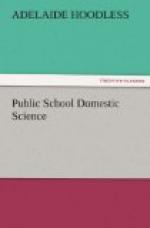Learn to receive instructions from the hostess in an undertone. Do not get excited and try to do too many things at once. It is an accomplishment to be a good waitress, as it requires special refinement and deftness, which are scarcely compatible with an untidy nature.
When serving meals without a waitress, the daughters of the house should consider it their special privilege to save the mother any annoyance or discomfort during the meal time. Never allow dishes, which have been used, to accumulate on the table or allow the table to become disordered. As much of the food as possible should be placed on the table before the family are seated, and the plates or dishes removed at once after using. No matter how simple the meal may be, every housekeeper should see that it is served neatly and on time. Teachers may exercise a far-reaching influence in the refining of home life by impressing upon the pupils the importance of these—too often considered—minor matters, and by giving minute instructions in the setting of table and serving the meal. One carefully planned practice lesson will convey more knowledge of such matters than any number of lectures or pages of theory.
* * * * *
CONSIDERATION OF MENUS.
The following menus and analyses are taken from bulletin No. 74, prepared in the United States Experiment Stations, and are inserted so as to give some idea of the cost and relative value of various foods in combination. It must be remembered that the prices given are in excess of prices in Ontario, therefore the cost per menu would be less than is given in these illustrations. The more expensive menus have been omitted. The writer of the article says:—
“In planning a well balanced diet the following points must be considered:—
(1) The use of any considerable amount of fat meat or starchy food should be offset by the use of some material rich in protein. Thus, if roast pork is to be eaten for dinner, veal, fish, or lean beef might well be eaten for breakfast or supper, or both. Bean soup furnishes a considerable amount of protein, while bouillon, consomme, and tomato soup are practically useless as a source of nutriment. Skim milk also furnishes protein, with but very little accompanying fats and carbohydrates to increase the fuel value.
(2) The use of lean meats or fish for all three meals would require the use of such foods as rice, tapioca, or cornstarch pudding, considerable quantities of sugar and butter, and more vegetables, in order to furnish sufficient fuel value.
(3) Since flour, sugar, and butter or lard enter very largely into pastries and desserts, the larger the quantities of these dishes that are consumed the larger does the fuel value tend to become as compared with the protein.”
The principal classes of food materials may be roughly grouped as follows as regards the proportion of protein to fuel value, beginning with those which have the largest proportion of protein and ending with those which contain little or no protein:—




